Sport & Heritage at the Tailteann Games
This year's Tailteann Games will bring five iconic traditions to life between 2pm and 6pm in Kells Priory. Each event will be presented as a demonstration by skilled athletes and practitioners who have dedicated years to studying and preserving these ancient forms.
The focus is not on competition, but on revival—sharing the spectacle, the story, and the spirit of Irish sporting heritage. Don't miss out get your tickets here
Please note: The ancient games are demonstrations only and not open to public participation.

The Five Demonstration Events
Wild Hurling
"He went off then with his wooden shield and his toy javelin, his hurley and his ball." — Táin Bó Cúailnge
Before Cú Chulainn was a warrior, he was a boy with a hurley and a ball. Wild hurling returns the game to its primal rhythm: no lines, no whistles—just skill, expression, and community. Led by Diarmuid Lyng, this demonstration shows how every strike of the camán echoes Ireland's oldest myths.
Rounders
"When they were engaged in driving the ball into the hole, he would fill the hole with his balls and the boys would not be able to ward him off." — Táin Bó Cúailnge
The "hole game" described in the myths lives on in modern rounders. It is a contest of timing, precision, and tactical awareness. This demonstration captures the artistry of play where every strike and sprint mirrors the contests once held at Emain Macha.
Stick Fighting (Bataireacht)
"No spearpoint which my hand forges will make a missing cast. No skin which it pierces will taste life afterward." — Cath Maige Tuired
Irish martial arts were about precision as much as power. In bataireacht, the ash stick or blackthorn shillelagh became an extension of the body—balance, timing, and focus. Today's demonstration honours the movements without the mayhem, showcasing the skill of the ancient dance of strike and defence.
Stone Lifting
"Then Ogma threw the flagstone, which required fourscore yoke of oxen to move it, through the side of the hall." — Cath Maige Tuired
From Tara to Tuired, the lifting of great stones was a test of strength and spirit. In this demonstration, athletes revive that tradition—not with gym equipment, but with raw stones that demand sheer grit and determination.
Tug of War
"Then a keen and cruel battle was fought between the race of the Fomoire and the men of Ireland." — Cath Maige Tuired
Epic struggles fill the myths: sides straining against each other in a test of will. Tug of war is the ritualised version of those ancient standoffs. Today's demonstration shows how coordination, rhythm, and resolve matter as much as raw power.
Why These Events Matter
The Tailteann Games are about more than sport. They are about memory, community, and cultural identity. Each demonstration is a reminder that the old contests were not simply games, but ways of binding people together—through story, skill, and shared tradition.